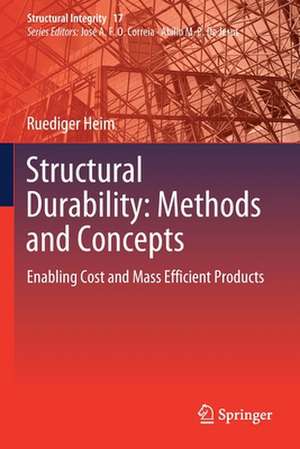Structural Durability: Methods and Concepts: Enabling Cost and Mass Efficient Products: Structural Integrity, cartea 17
Autor Ruediger Heimen Limba Engleză Paperback – 30 mai 2021
| Toate formatele și edițiile | Preț | Express |
|---|---|---|
| Paperback (1) | 637.13 lei 6-8 săpt. | |
| Springer International Publishing – 30 mai 2021 | 637.13 lei 6-8 săpt. | |
| Hardback (1) | 643.34 lei 6-8 săpt. | |
| Springer International Publishing – 30 mai 2020 | 643.34 lei 6-8 săpt. |
Din seria Structural Integrity
- 18%
 Preț: 956.69 lei
Preț: 956.69 lei - 18%
 Preț: 1396.43 lei
Preț: 1396.43 lei - 17%
 Preț: 461.25 lei
Preț: 461.25 lei - 24%
 Preț: 1331.37 lei
Preț: 1331.37 lei - 15%
 Preț: 641.38 lei
Preț: 641.38 lei - 18%
 Preț: 1847.84 lei
Preț: 1847.84 lei - 18%
 Preț: 942.76 lei
Preț: 942.76 lei - 15%
 Preț: 699.28 lei
Preț: 699.28 lei - 15%
 Preț: 637.28 lei
Preț: 637.28 lei - 18%
 Preț: 777.69 lei
Preț: 777.69 lei - 18%
 Preț: 1219.63 lei
Preț: 1219.63 lei - 18%
 Preț: 940.57 lei
Preț: 940.57 lei - 18%
 Preț: 1223.55 lei
Preț: 1223.55 lei - 15%
 Preț: 637.59 lei
Preț: 637.59 lei - 18%
 Preț: 1562.17 lei
Preț: 1562.17 lei - 20%
 Preț: 997.06 lei
Preț: 997.06 lei - 18%
 Preț: 1546.68 lei
Preț: 1546.68 lei - 18%
 Preț: 1384.44 lei
Preț: 1384.44 lei - 18%
 Preț: 1111.85 lei
Preț: 1111.85 lei - 18%
 Preț: 1564.23 lei
Preț: 1564.23 lei - 18%
 Preț: 944.99 lei
Preț: 944.99 lei - 18%
 Preț: 957.32 lei
Preț: 957.32 lei - 15%
 Preț: 643.00 lei
Preț: 643.00 lei -
 Preț: 436.35 lei
Preț: 436.35 lei - 18%
 Preț: 1221.51 lei
Preț: 1221.51 lei
Preț: 637.13 lei
Preț vechi: 749.56 lei
-15% Nou
Puncte Express: 956
Preț estimativ în valută:
121.91€ • 127.63$ • 100.88£
121.91€ • 127.63$ • 100.88£
Carte tipărită la comandă
Livrare economică 05-19 aprilie
Preluare comenzi: 021 569.72.76
Specificații
ISBN-13: 9783030481759
ISBN-10: 3030481751
Ilustrații: XV, 209 p. 128 illus., 115 illus. in color.
Dimensiuni: 155 x 235 mm
Greutate: 0.33 kg
Ediția:1st ed. 2020
Editura: Springer International Publishing
Colecția Springer
Seria Structural Integrity
Locul publicării:Cham, Switzerland
ISBN-10: 3030481751
Ilustrații: XV, 209 p. 128 illus., 115 illus. in color.
Dimensiuni: 155 x 235 mm
Greutate: 0.33 kg
Ediția:1st ed. 2020
Editura: Springer International Publishing
Colecția Springer
Seria Structural Integrity
Locul publicării:Cham, Switzerland
Cuprins
Introduction & Motivation | Durability management.- Load time histories and counting methods.- Load and stress spectra S/N curves and their characterization.- Damage accumulation and fatigue life assessment.- Fatigue strength of materials and components.- Improving fatigue strength.- Accelerated life testing and math modeling.
Notă biografică
Ruediger Heim is a mechanical engineer who has been involved in road vehicle product development and research since 1992. He graduated from Technical University Darmstadt, having his focus on material science and automotive engineering. Before he joined Fraunhofer LBF, he was working many years for an engineering service supplier at sites in Cologne, Stuttgart and Ruesselsheim, supporting automotive body engineering programs. The attributes he was working on, were primarily crashworthiness and structural durability.
Beyond traditional approaches for body engineering, he was introducing novel solutions such as rigid polyurethane foam to stiffen relevant cavities of the body structure. In 2005 he joined Europe's largest organization for applied research: the Fraunhofer-Gesellschaft. At the Fraunhofer-Institute for Structural Durability and System Reliability in Darmstadt he is now in charge of an R&D division as well as he is deputy director of the institute since 2014. Parallelto his focus on structural durability, he is strongly involved in R&D activities related to low & zero emission vehicles. At the University for applied Science in Kaiserslautern he is giving a lecture in “structural durability” for an international master´s study program.
Beyond traditional approaches for body engineering, he was introducing novel solutions such as rigid polyurethane foam to stiffen relevant cavities of the body structure. In 2005 he joined Europe's largest organization for applied research: the Fraunhofer-Gesellschaft. At the Fraunhofer-Institute for Structural Durability and System Reliability in Darmstadt he is now in charge of an R&D division as well as he is deputy director of the institute since 2014. Parallelto his focus on structural durability, he is strongly involved in R&D activities related to low & zero emission vehicles. At the University for applied Science in Kaiserslautern he is giving a lecture in “structural durability” for an international master´s study program.
Textul de pe ultima copertă
This book provides methods and concepts which enable engineers to design mass and cost efficient products. Therefore, the book introduces background and motivation related to sustainability and lightweight design by looking into those aspects from a durability and quality point of view. Hence this book gives a "top-down" approach: What does an engineer has to do for providing a mass and cost efficient solution? A central part of that approach is the "stress-strength interference model" and how to deal with "stresses" (caused by operational loads) as well as with the "strength" of components (provided by material, design and manufacturing process). The basic concepts of material fatigue are introduced, but the focus of the volume is to develop an understanding of the content and sequence of engineering tasks to be performed which help to build reliable products. This book is therefore aimed specifically at students of mechanical engineering and mechatronics and at engineers in professional practice.
Caracteristici
Introduces a background for engineering design related to mass and cost efficiency which helps to feel motivated positively Top-down approach" for learning structural durability rather than starting with complex, submicroscopic mechanisms of material fatigue Engineering/design process oriented Combines sound knowledge about fatigue and durability concepts with engineering process orientation to deliver solutions
